By Philip Cauchi
Introduction: In today’s session our focus will be on group collaboration during the defending phase. This training session challenges the players to work together and apply the correct solutions to the problems they will face. The main aim is to have a compact defensive unit with the intention of forcing the opponents to play into zones where we have a higher probability of winning the ball. When the ball is played into these specific zones we apply pressure on the ball thus reducing the playing options of the opponents, regain possession and counter.
Players: Two goalkeepers and sixteen outfield players.
Total duration: Approximately 80 minutes.
Moment of play: Opponents in possession.
Team task: Prevent scoring.
Theme: Defend to win the ball and counter.
Main aim: Force opponents into pre-establish zones to press and win the ball.
Outcomes:
1. Maintain a compact defensive block.
2. Make play predictable.
3. Overload area around the ball.
4. Mark potential passing receivers.
5. Double team opponent on the ball.
6. Win the ball and counter.
Equipment:
Balls, bibs, markers, mini goals (four) and two regular goalposts.
N.B. The practices and small-sided games shown in the session are to be carried out by two groups simultaneously.
Activation: 3v1 rondo.
Targeted outcomes: n/a.
Duration: 10 minutes.
Players: Three attackers and a defender.
Area: 8 yards by 6 yards.
Description: Prior to this activity players should perform some work using the agility ladder where the main aim is to switch on the neuro-muscular system. In the 3v1 rondo, the three attackers aim to make six consecutive passes to score a point within forty seconds. The defender’s aim is to prevent this, win the ball and dribble it out of the area to score three points for himself.
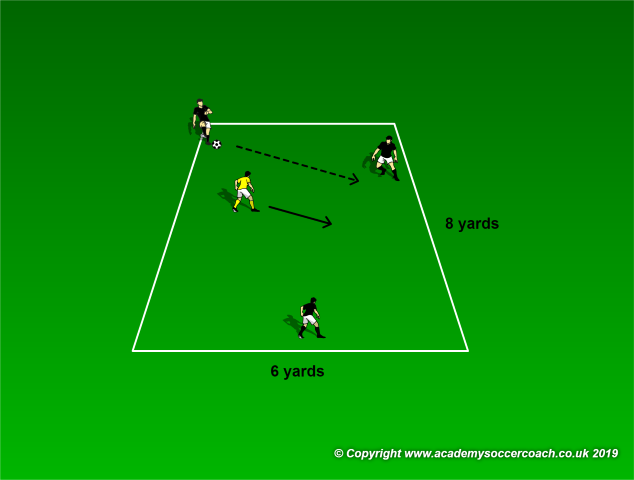
The 3v1 rondo activates the defender’s brain to think of a way to prevent the attackers from having the necessary space to freely make the passes. Furthermore, the defender aims to make play predictable into a part of the playing area where the attackers’ ability to play the ball becomes limited, thus increasing the defender’s chances of winning the ball.
Practice 1: Prevent the through pass and win the ball to counter.
Targeted outcomes: 1, 4, 5 and 6.
Duration: 12 minutes – rest between restarts and attacks is included.
Players: A goalkeeper, three defenders and five attackers.
Area: 20 yards by 15 yards.
Description: In the high area the attackers circulate the ball with the intent of passing it to their team mates in the low area through the middle zone. Three defenders guard the middle zone. If the attackers manage to pass the ball to their team mates inside the low area, they must make at least one pass before they can score. In this case the defenders retreat to the low area to defend. One attacker from the high area may follow the action and inserts himself in the low area. In the low area the goalkeeper helps the defenders from conceding a goal by defending the two mini goals. The defenders aim to prevent the attackers from scoring, win the ball and initiate a counter attack on the opposite two mini goals. Instead of two mini goals, a goal with a goal keeper may be used. This will increase the level of motivation in the defenders to win the ball and counter at speed.
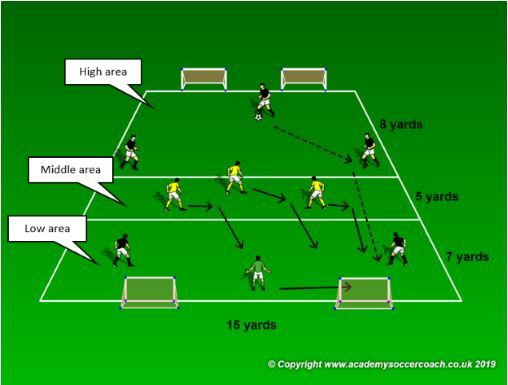
Practice 2: Defending high.
Targeted outcomes: 1, 4, 5 and 6.
Duration: 12 minutes – rest between restarts and attacks is included.
Players: Three attackers and three defenders are positioned in the high area while another two attackers are positioned in the low area.
Area: 24 yards by 15 yards divided into two equal horizontal zones (low and high areas).
Description: Attackers 7, 8 and 11 aim to play the ball to attackers 9 and 10 while being pressured by defenders 6, 8 and 10. If the pass to attackers 9 and 10 is through, the attackers must make at least one pass before they attempt to score on the regular goal. The defenders must immediately retreat to the low area to prevent conceding a goal. If the defenders win the ball they counter on the opposite two mini goals. To encourage more collaboration and more efficient communication in preventing the attackers to pass to attackers 9 and 10, reward the defenders with two points for every time they score after winning the ball in the high area. This also increases the intensity of applying pressure on the ball and the quality of pressing actions.
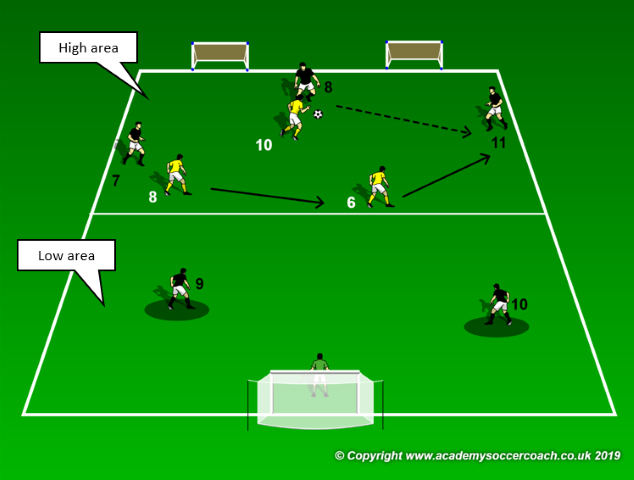
Game 1: 4v4+GK.
Targeted outcomes: All.
Duration: 15 minutes (four x three minutes with one minute of rest).
Players: One team of four players (defending team) and another team consisting of a goalkeeper and four players.
Area: 30 yards by 25 yards.
Description: Normal match where the yellow team defends the two mini goals and attack the opposite regular goal. In this game we simulate defending from the front where the black team aims to play the ball in either of the two mini goals. These two mini goals represent passing lanes towards the midfielders and/or strikers. As such the defending team must collaborate together to prevent the ball from being passed to the strikers.
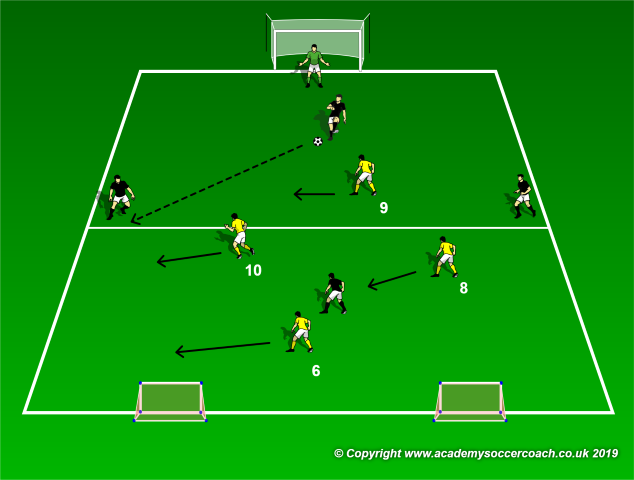
The attacking team may only score from inside the defending team’s defending half. To progress and make it more challenging for the defending team, remove the mid line and have the attacking team score from anywhere on the pitch. This forces the defenders to recognise the moment of when to drop as a unit and when to press aggressively to win the ball.
Game 2: Defending in different situations.
Targeted outcomes: All.
Duration: 18 minutes (two x eight minutes with two minutes of rest).
Players: Two groups of eight players and a goalkeeper.
Area: 55 yards by 35 yards divided into two zones.
Description: Normal game where the defending team experiences defending in various situations. Within these situations the defenders can be outnumbered as is the case in the below illustrated image or defending in numerical parity. The attacking team may be asked to be strategically positioned in a particular formation. This forces the defending team to quickly adjust to the newly applied circumstances. Quick collaboration and a high level of communication and concentration is needed to be successful in preventing the opposition from scoring and regaining possession, especially when defending in numerical inferiority.
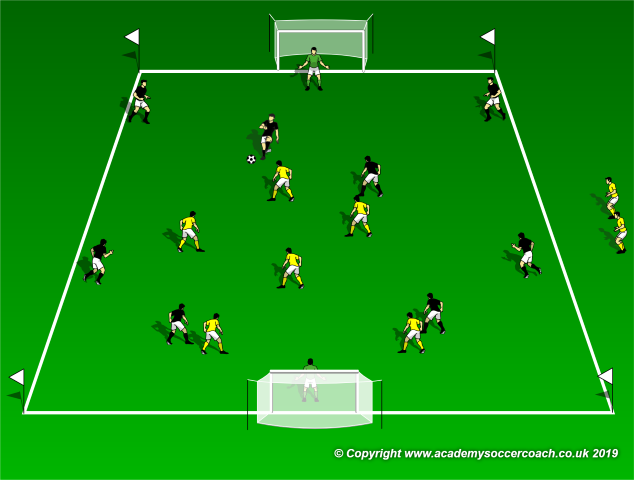
In the above illustration, two players from the defending team are temporarily removed so that the players must quickly reorganise themselves to defend in the new situation. These two players can be rotated with new ones every minute.
Conclusive part.
Duration: 10 minutes.
In the conclusive part the players perform light passing in pairs as a cool down. Static stretching exercises may also be carried out in the final five minutes.
By Philip Cauchi


